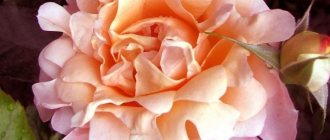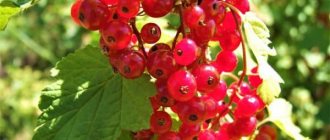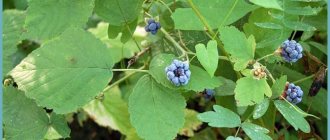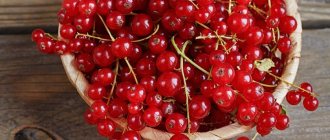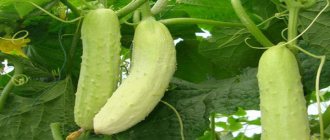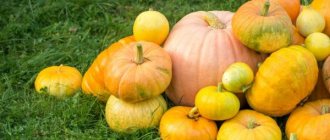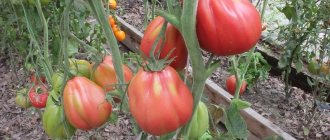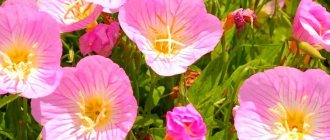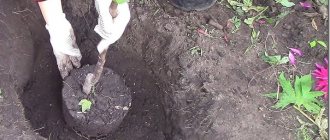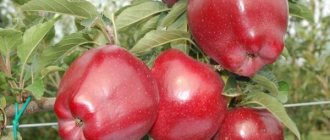There are different stories about the appearance of currants with an unusual green color in Russia. There are several versions. According to the first of them, this unusual crop was bred by Siberian breeders in the Soviet Union in the thirties of the last century.
The reasons why the new product was not appreciated are not clear. What is known is that green currants were soon forgotten in their homeland. But European scientists were interested in Siberian exotics, so much so that Finnish and German breeders, based on the original source, developed new varieties of green-fruited plants (as the Siberians called it). And they, in turn, came back to us, but as foreigners.
The second version makes a few additions to this story. According to it, Russians became acquainted with green-fruited plants back in the 19th century, when foreign currant seedlings began to be imported to us. From the European part of the country they came to Siberia, where local breeders developed their variety.
Description of green currant
It doesn’t make much sense to describe the green-fruited currant in detail, since it belongs to the chokeberry variety. It just differs in its green fruits. The berries get this color due to the absence of coloring substances in them - anthocyanins, which give the black tint to chokeberry fruits.
This type of currant has not gained much popularity in our gardens. The main reason for this is that gardeners do not accept the green color of the berries. After all, everyone is accustomed to black, red, golden fruits.
Therefore, you can hardly find green seedlings in fruit nurseries.
Description of the bush, fruits and leaves
The bushes are mainly of mid-season type with slight spreading. The bushes are medium-sized. Young shoots are straight and bright green in color. As they grow older, the color of the bark becomes lighter.
The flowers, like those of pink currants, resemble a small glass in their shape. Collected in an inflorescence. The brush is 6-9 cm in size, on which there are from 12 to 18 fruits.
The fruits of the green fruit differ from the black fruit not only in color, but also in taste. They do not have the traditional currant taste.
The green-fruited leaves have the traditional shape of blackcurrant - with five lobes. Quite large in size and light green in color.
There are no growths on the leaves of green currants, they are smooth to the touch, no roughness.
Compared to black ones, the fruits ripen somewhat later - the end of July, or even the beginning of August. In early spring, the harvest may ripen a little earlier than the specified dates. Gardeners also see advantages in late ripening - the period of consumption of fresh berries is extended for another month.
The yield of green is quite high - up to 5 kg can be harvested from one bush.
Green currants: how to plant correctly
Planting green currants in the garden can be done both in spring and autumn. The most suitable period is autumn. Currants are an unpretentious plant, but prefer to grow in moist, fertile, well-drained soils with an average level of acidity. When preparing holes, maintain a distance of about 1 meter between them. The dimensions of the hole should be 50x50 centimeters and go 40 centimeters deep into the ground. After this, add fertilizer to the surface layer made with compost, wood ash, potassium and phosphate at the rate of 2 x 200 g. x25 gr. x200 gr. After the soil for planting is ready, you need to cut off the top of the plant, leaving two young branches on which there should be from 3 to 4 buds. It should be planted at a 30o angle and cover the root collar with soil no more than 10 centimeters. Next, the ground must be covered with peat or humus mulch; this will not only retain the moisture the plant needs, but also stop the growth of weeds. You can water the plant only after three days. Keep in mind that for normal development, currants need at least 1 square meter. m. on the site.
Beneficial features
In terms of its usefulness, green-fruited currants are in no way inferior to other varieties and types of currants.
Composition of green currants
It contains a lot of useful substances required for the human body. It boasts provitamin A, a whole series of vitamins - C, I, P, E and others. The vitamins in red currants are identical. In addition to the above, it contains the following acids: phosphoric, malic, citric, oxalic.
Also includes:
- pectins;
- essential oils;
- healthy sugars;
- fiber – it is good for the intestines and stomach.
Agricultural technology
Agrotechnical activities include:
- correct choice of landing site;
- choosing a variety for a specific region;
- acquisition of viable planting material;
- soil preparation;
- planting and further care.
Did you know? During World War II, a large portion of the European population became vitamin C deficient due to difficulties importing and growing oranges. As a result, the cultivation of black currants has become widespread.
Choosing a place and landing
The green-fruited currant variety Emerald needs constant light, so you need to choose a sunny (perhaps slightly shaded) place, ideally on the south side of the garden. In the shade, the bush will bear fruit worse, and the berries will be less sweet than those that ripen in the sun. You should choose a damp place, protected from cold winds and late frosts. Despite the fact that the Emerald variety shows good frost resistance, cold winds can damage the flowers in the spring.
The place should be free of stagnant groundwater. The soil should be slightly acidic pH 6.0–6.5, loose and fertile. To reduce acidity, add 500 g of lime per 1 m² to the soil. When planting multiple seedlings, keep them 1.2-1.5m apart in rows and spaced about 1.8-2.4m apart. If the plant is planted as a hedge, then this interval can be shortened.
You can plant Emerald Necklace currant bushes under grapes, peach trees, cherries and pears. It is recommended to plant bushes in the fall. You can do this in the spring, avoiding the frost period. If you plant seedlings in the spring, the plant will require regular watering during the first months.
Preparing the soil for planting:
- 2-3 weeks before planting, remove all weeds in the planting area.
- Dig a hole 50 cm in diameter, 60 cm deep.
- Drain the soil well with sawdust, shards, crushed bricks, pebbles or crushed stone. When using crushed stone, you need to add a couple of handfuls of sand to the hole.
- Add organic matter to the planting area: rotted manure or garden compost, 5 kg per 1 m².
- Immediately before planting, add 2 tbsp under each bush. spoons of double granulated superphosphate, as well as 1 tbsp. a spoonful of urea and potassium, without chlorine. Add a layer of soil on top again so that the roots of the plant do not touch the fertilizer and get burned.
- Fill with 1 bucket of water.
Medicinal properties and contraindications
Eating green currant fruits will lead to:
- bowel function will return to normal;
- immunity will increase;
- nails and hair will become stronger;
- visual acuity will be maintained.
The fruits can also be consumed as a prophylactic for problems with the cardiovascular system. They have shown high effectiveness in the treatment of both types of diabetes. Green fruits will be useful even for cancer patients. True, in the last two cases only as part of complex treatment.
Green berries are also valuable for allergy sufferers - they do not contain coloring pigments, which means that painful reactions are not possible.
According to laboratory studies, berries are also indispensable in the treatment of atherosclerosis.
Women will be interested in the information that vitamin E contained in fruits gives elasticity to the skin. This way you can delay the approach of old age.
Of the minuses, it is worth noting that people with ulcerative lesions of the stomach and intestines need to be more careful.
To satisfy the body's daily need for ascorbic acid, it is enough to eat about 20 berries every day.
How to choose the right seedling for planting
Choose seedlings among those that are already 2 years old. The most important thing for good survival and development is the root system, so this will be the main thing you need to pay attention to. The seedling should have two or three main roots, many thread-thin roots. The length of the roots should be at least 20 centimeters and the color should be light brown, with a shade of white in place of the branches. If you notice that the roots are dark or brown in color, then you should not take such seedlings, as this is a sign of disease, freezing, or that the plant has been overdried.
The branches of the selected plant must be woody, mature and at least 30 centimeters in length. Also pay attention to the presence of shoots, there should be 1 or 2 of them. There should be no spots or signs of lethargy on the currants, as this indicates the presence of a disease. You should purchase seedlings or cuttings either from your good friends whose plant is healthy, or from a specialized store or nursery.
Varieties
Over the hundred years of existence of green, breeders have developed a large number of varieties.
Emerald necklace
A variety of domestic selection with a medium-late harvest ripening period (late July - early August). The fruits are pale greenish in color, even light yellow, and large in size. The taste is sweet and sour. The bush itself is low-growing with a spreading crown.
The fruits can be consumed fresh or made into preparations. You can also freeze them, without losing their beneficial qualities.
During operation it showed high resistance to low temperatures, diseases and pests.
The cluster contains an average of 9-10 berries weighing up to 1.3 g on average. On the taste scale they were given 4.3 points out of five possible. Each bush produces from 2.6 to 2.9 kg of tasty and healthy berries.
The advantages of the Emerald Necklace variety include:
- self-fertility;
- crop stability;
The disadvantages are the small size of the berries.
The Snow Queen
A variety based on the Constantia cultivar has been developed. Refers to varieties of mid-season ripening. Actively growing type of plant, medium-sized, slightly spreading.
Each cluster contains up to 18 berries with an average weight of 1.2 g. In terms of taste, the fruits received 4.4 points.
The Snow Queen is a self-pollinating variety. Each bush can produce up to 2.6 kg of berries.
Vertti
Finnish selection, of all foreign varieties in Russia, is the most popular among domestic gardeners.
This variety is easily recognizable due to the brown speckles on the berries.
According to reviews, its fruits cannot be considered beautiful, but all this is compensated by the excellent taste and aroma of the berries. A distinctive feature of the variety is that the bush begins to bear fruit from the first year of planting. Harvest ripening occurs in the second half of summer - late July, early August.
Measures to combat gall aphids on red currants are described in this article.
In the Russian climate, the variety feels great and easily tolerates our winters. True, if frosts stay below minus 30 for a long time in winter, then flower buds often freeze.
Gardeners note high resistance to various diseases, especially those caused by fungi. It is also noted that Vertti is practically not touched by spider or bud mites, which are the scourge of aronia.
The fruits are oval-shaped, quite large, green in color.
Pros and cons of growing on site
Like any other crop, green currants have both pros and cons.
The main advantages of this type of currant are:
- Large-fruited - ripe green currant berries weigh up to 4-5 grams.
- Frost resistance - most varieties of this crop can withstand not only winter frosts, but also early spring frosts.
- Hypoallergenic - unlike black currants, berries of green-fruited varieties do not cause allergies.
- High resistance to diseases and pests - most varieties of modern domestic and foreign selection are resistant to diseases and are weakly susceptible to attacks by pests.
- Invisibility for birds - ripe berries do not stand out against the background of foliage, so they are not pecked by birds.
- Sweet taste and thin skin of ripe berries.
The few disadvantages of green currants include:
- late ripening period (August-September) - the harvest of green-fruited currants ripens much later than the varieties of black-fruited or red-fruited;
- shortage of seedlings - seedlings of this crop are not yet widespread, so purchasing them is not as easy as the more familiar varieties of black and red currants.
Also, a minor drawback of this crop is the lack of a detailed description of the growing technology.
See also
Description and characteristics of red currant variety Sugar, planting and careRead
Growing
The process of growing green-fruited currant varieties is not very difficult. Agricultural technology is in many respects similar to caring for black and golden currants. It is important to provide fertile soil with moderate humidity, or preferably moderate. The last condition will ensure a minimum of diseases for the bush.
Landing
When placing seedlings on the site, you must adhere to the standard planting scheme. The distance between bushes should be at least 0.7 and up to 1 meter. Holes for seedlings are dug up to 35 cm deep and up to 6 cm wide.
Before planting, add a nutrient mixture to the holes, including the following components:
- 1 bucket of humus or compost;
- from 150 to 200 grams of superphosphates;
- 25 grams of potash fertilizer;
- 0.5 kg of wood ash.
When planting, the seedling is placed at an angle of up to 40 degrees. The root collar is covered with earth up to 10 cm, and the above-ground part is cut off so that no more than 5 buds remain on the branch. The latter will allow the shrub not to waste energy on feeding the above-ground branches, but to speed up the rooting process and the formation of new shoots.
We recommend that you read about the use of ammonia for aphids in this material.
The cut parts of the seedling can also be buried for rooting, following the planting technology.
After planting the seedling, the perimeter of the planting hole is mulched with peat. This procedure will maintain the necessary humidity. After 3 days, the surface of the planting hole should be re-mulched with peat, after watering. If the weather was rainy, then mulching is not necessary.
Selection of seedlings
You should be careful when choosing seedlings for planting, since the survival rate of the shrub, as well as the future harvest, largely depend on their quality. Due to the limited popularity of green currants, they should be purchased from highly specialized nurseries and gardening farms. You can find seedlings in a number of breeding and educational farms.
The best option would be shoots two years old. When choosing, you should pay attention to a number of features of the processes:
- The seedling must have at least three skeletal roots - these are the largest root processes extending from the main stem.
- The main stem should be dense, without mechanical damage, abrasions or cracks. The presence of the latter indicates diseases of the bush or its careless storage and transportation.
- The buds on the shoots should be dense and elastic.
When purchasing, you should carefully examine the condition of the seedlings, especially the root system.
At the same time, when purchasing, it is important to find out the formation of the zoning of a variety - its fitness and adaptation to a specific region. Most often, green-fruited varieties are sold by Siberian breeders. They are relevant for growing in regions with cool climates and short summers. The latter is explained by the fact that the ripening period of berries of such varieties is shorter than that of seedlings of southern selection.
Place and time of landing
The best time for planting green fruit is in the spring, although agronomists recommend planting in early autumn. The last rule is relevant for the southern regions. In the northern regions it is better to plant at the end of May. If you decide to plant currants in the fall, then the optimal time will be the end of August or the beginning of September. Over the summer and autumn, the shrub will have the opportunity to adapt to new conditions, take root well and sprout new shoots.
For planting, you should choose open areas with moderately moist, slightly acidic soils.
It is better to plant seedlings after rain, preferably the next day. The best time is considered to be from 11 am to 2 pm. The soil should be well drained, but not deprived of moisture. Swampy places and the shady side are not suitable for permanent placement of green currant bushes. The landing site should be on the south side, always sunny. If there is a risk of partial shade, then the period should occur in the first half of the day. It is important that the bush is in the sun most of the daylight hours.
You can find folk remedies for aphids at the link.
It is recommended to prepare the landing site in advance. So, a year before planting, humus, peat or sawdust should be added to the soil in combination with phosphate and potash fertilizers.
You should also dig up the soil with the addition of wood ash, and also treat it against insects.
Currant Emerald Necklace with green berries, reviews about green fruit
Currants with green fruits belong to the varieties of chokeberry (Ribes nigrum). This unusual berry appeared in the 30s of the last century thanks to the efforts of Siberian breeders. However, currants did not receive the expected success among gardeners. Therefore, they forgot about her for a long time. Meanwhile, green berries attracted the interest of breeders in Finland and Germany.
European horticultural scientists took an exotic plant as a basis and began to experiment. As a result, new varieties appeared, which subsequently came back to Russia.
Varieties
The green color of the berries is inherited from Siberian and Scandinavian blackcurrant varieties. At the All-Russian Research Institute of Genetics and Selection of Fruit Plants named after I.V. Michurin, 77 green-fruited currant seedlings were produced through hybridization, free and forced pollination.
Vertti
This is a variety of Finnish selection. The berries have a light green color, thin skin, excellent taste and aroma. The shrub is able to bear fruit after the first year of life. The berries ripen in late June - July. Productivity is above average. The variety is cold-resistant, but in prolonged frosts of -30°C, flower buds may be damaged.
The positive qualities of the Vertti variety include resistance to fungal diseases. Spider mite damage is rarely observed, which causes considerable harm to black currants.
Emerald necklace
This currant variety is one of the best representatives of Russian selection. The fruits are large, light yellow, with a pleasant sweet and sour taste. The berries are well stored frozen without losing their beneficial qualities. Medium-late ripening variety. The bush is spreading and low growing. Read about the best varieties of currants for the Moscow region in this article.
The emerald necklace is characterized by high frost resistance and disease resistance. Not attacked by harmful insects.
Useful qualities
Green currant berries are considered beneficial to human health because they contain:
- provitamin A;
- vitamins C, B, P, E A;
- carotene;
- phosphoric acid;
- citric, oxalic, malic acids;
- pectin substances;
- essential oil;
- healthy sugars;
- cellulose.
Accordingly, each component of the fruit has a beneficial effect on the body as a whole.
With obvious benefits, more and more gardeners are choosing this subspecies of currants for growing in their summer cottages.
Eating fruits contributes to:
- normalization of intestinal function;
- increasing immunity;
- prevention of the cardiovascular system, diabetes and even cancer;
- strengthening nails and hair;
- maintaining visual acuity.
In addition, the fruits of green currants are indispensable for atherosclerosis; vitamin E gives the skin elasticity.
To meet the body's average daily requirement for ascorbic acid, you need to eat about 20 fresh berries daily.
Features of decorative currants
It should be noted that green forms of currants are not inferior to chokeberry fruits in terms of the content of biologically active substances. In addition, they do not have a pronounced currant taste. The berries of green varieties are juicy, sweet, with a delicate aroma.
Allergy sufferers should pay special attention, because green-fruited varieties do not cause allergic reactions.
Their ripening period mainly occurs in August, by which time the harvesting of even late varieties of red and black currants comes to an end. Ripe berries can hang on the bush until September.
And thanks to their green color, the fruits remain invisible to birds. The average yield per bush is 3-5 kg. This material will tell you what to plant next to currants.
Growing
The subspecies does not cause significant trouble to owners during the growing process. However, varieties of green-fruited currants are not in sufficient demand, so purchasing a seedling is not easy. Even in nurseries, green currants are not always available.
Selection of seedlings
It is recommended to choose two-year-old seedlings. Pay special attention to the root system. It should consist of 2-3 main roots of light brown color and at least 20 cm long.
In addition, the underground part of the plant should have a large number of thread-like roots. It is important that the branches have a white tint when cut.
A dark brown or brown color indicates dryness, freezing or diseases of the young plant.
Find out about brown spots on currant leaves at this link. The ground part should have mature, woody branches up to 30-40 cm long.
The seedling may have 1-2 strong shoots. A healthy plant does not have spots or signs of wilting on the vegetative part, otherwise this may indicate the presence of a fungal infection.
You can buy currant cuttings from gardeners who have personally experienced the benefits of the variety.
Landing
The best time for planting green currants is autumn. However, the process can be carried out in the spring before the buds open. It is preferable to choose moist, fertile soils, sandy loam or loam.
The required soil pH is 6-6.5. If there is an excess of water, the bush may grow poorly and eventually die. It is worth planting bushes, keeping a gap between them of 0.8-1 meter.
Read about planting currants in spring here.
First of all, dig a hole measuring 50x50 cm and 40 cm deep. Then add 1.5-2 buckets of compost or humus, 200 grams of wood ash, 25 grams of potash fertilizers, 200 grams of superphosphate. The surface layer of the recess is mixed with fertilizers.
The upper part of the plant is cut off, leaving a pair of young branches with 3-4 buds. The seedling is placed in the hole at an angle of 30°, and the root collar is sprinkled with soil to a depth of 7-10 cm. The soil around is mulched to retain moisture using humus or peat. Three days later, the currants are watered abundantly.
A green currant bush needs 1-2 sq. meters of area.
Features of care
- The berry crop should be planted in a well-lit area.
- A prerequisite is sufficient drainage to prevent fluid stagnation.
- In spring it is recommended to apply humus and mineral fertilizers.
- Feed with organic matter in the fall. Find out about potato peelings for currants here.
- Water intensively during fruiting in July-August. Pour 1 bucket of water under the bush.
- To increase yield and increase the size of berries, preventive pruning is carried out.
- The procedure for thinning branches is carried out in April or autumn, after harvesting.
Mulching the tree trunk circle can protect the plant from the harmful effects of frost and snow; it is made from straw or peat.
- It is recommended to promptly remove the plant from branches lying on the ground and shoots that are more than five years old.
- Weed weeds and loosen the soil in a timely manner.
- If necessary, treat currants with drugs against infections or pests (caterpillars, root-knot aphids, scale insects).
Reproduction
The principle of propagation of green currants is no different from black currants. You can propagate shrubs using woody, green branches, dividing the bush or horizontal layering.
- By cuttings. In September-October, several strong branches are selected and cuttings of 15-20 cm are cut. The lower cut above the bud is made at 45°C, and the upper cut is straight. Next, in autumn or spring, the cuttings are planted in specially prepared trenches. Planting is done every 10 cm, leaving 2 healthy buds on top. Afterwards, supports are installed, watered abundantly and mulched with peat or humus.
The larger the cutting, the more nutrients it contains, but the total amount will decrease.
- By layering. This method is quite simple to implement. In early spring, before the buds appear, the cuttings are bent to the ground and dug in. In this case, the soil around the bush should have a loose, light consistency and be sufficiently saturated with nutrients. Place the shoots in grooves 6-8 cm deep, pinch them to the surface of the ground with hooks and install a bush holder. When shoots appear from the buds and grow up to 10 cm in size, they should be covered with earth. After 2 weeks, repeat the procedure. In the fall, transplant ready-made seedlings separately.
Figure: Reproduction of currants by layering.
- Dividing the bush. In spring or autumn, currants are dug up. All old shoots are cut off, leaving only young, healthy ones. Using a sharp hatchet or knife, divide the rhizomes so that each part has buds on the branches and a well-developed root system.
As a rule, this method is not abused - it is a necessary measure to preserve the variety and transfer the bush to a new place.
Advice from gardeners
Gardeners often experiment in their summer cottages in order to obtain a good harvest. Basic recommendations from experienced gardeners for growing currants:
- if the site has sandy soil, then before planting it is worth adding 4-5 buckets of humus under the bush;
- Before flowering, water abundantly. The bush should be moistened until the water stops being absorbed;
- use duckweed as mulch;
- when fertilizing with complex mineral fertilizers, add a few more handfuls of ash;
- Feed green-fruited currants with horse manure twice a season.
about the green-fruited currant Vertti.
conclusions
- Green currants are a source of beneficial micro and macroelements. It is recommended to use it to prevent various diseases.
- The green-fruited form is not an allergenic product, unlike other subspecies of currants.
- Russian varieties are distinguished by good indicators of cold resistance, disease resistance, unpretentiousness to watering and growing conditions.
- The fruit plant prefers open areas; the slightest shade can negatively affect the taste and size of the berries.
- Berry picking can be done until mid-September.
Source: https://PoFerme.com/sad/kustarniki/smorodina/zelenoj.html
Care
This ease of care is one of the reasons for the popularity of currants. Green-fruited varieties are also not demanding of care. For young seedlings, careful care is important during the first week after planting.
Every spring, humus must be added to the soil around the bush. In especially rainy summers, the soil around the bush must be mulched with peat.
The main stages of caring for an adult shrub are as follows:
- watering during flowering and fruiting in dry summers;
- thinning branches in early spring or after harvest;
- pruning old shoots and branches lying on the ground;
- weeding and loosening the soil around the bush;
- preventive pruning of bushes older than two years;
- feeding and treatment against infectious diseases and pests.
Watering
It is necessary to water the plant during flowering and fruiting. If it rains at this time, it is not recommended to water the bush. In addition, watering is carried out the first time after planting if the weather is dry.
Read how to fight aphids on black currants here.
In June, during the flowering period, if there is no rain, one bucket of water is poured under one bush once a week. 1/4 buckets are poured under just planted bushes.
Feeding
For fertilizing, mixtures of potassium phosphate and organic fertilizers are used. It is recommended to fertilize twice a season - in early spring when the first leaves appear and immediately after harvesting.
Fertilizing can be applied in combination or individually. Organic fertilizers in the form of compost and peat can be applied at any time of the season.
The latter should predominate in the potassium-phosphate mixture, and they should be added at the end of April, beginning of May or in September. Before wintering, the plant should be watered.
Trimming
Pruning should be divided into preventive and thinning. For prevention, pruning is carried out in early spring. It involves removing old and frozen branches. Thinning is carried out after fruiting and harvesting. The shrub is removed from branches that have fallen to the ground, as well as those that have grown excessively or stretched in height.
You can find a list of remedies for aphids on currants and berries here.
Reproduction
In order to propagate shrubs, the inclined soils are dug up, and after they are rooted, they are pruned and replanted. The shoots should be dug in after fruiting, and the shoots should be pruned in April-May of the following year. You can also root cuttings after pruning.
Diseases and pests
The key feature of green-fruited varieties is that they are practically not susceptible to fungal and infectious diseases. Therefore, a healthy green currant bush will not crumble. Pests also rarely attack shrubs. It is advisable to treat aphids after flowering.
How to propagate green crops
The main methods of propagation of green currants are as follows:
- Cuttings - during autumn sanitary pruning, cuttings 15-20 centimeters long, with 2-3 buds, are cut from cut shoots. In this case, the cut under the lower bud is made straight, and above the upper one - at an angle of 45. Such cuttings are planted on a previously prepared bed (school), placing each of them at an angle of 40-45. Before rooting, the cuttings are watered moderately. For the winter, rooted bushes are dug up and placed in a cellar for storage or insulated with a layer of foliage, straw, or spruce branches.
- Horizontal layering - with this method of propagation, 2-3 strong shoots are bent to the ground in early spring, fixed with small pins and covered with earth, leaving 5-10 centimeters of the top. As they take root and shoots appear, the layering is additionally spudded. In the fall, the rooted cuttings are separated from the mother bush and transplanted to a permanent place.
- Dividing the bush is the easiest way of vegetative propagation. It involves dividing the old mother bush into two parts with a sharp knife, followed by transplanting each of them to a permanent place.
Propagation by seeds (generative) is not used in summer cottages and garden plots.
conclusions
- Green-fruited currants can be eaten fresh. So in numerous preparations. Can also be frozen.
- It is unpretentious and frost-resistant. Many varieties.
- The fruits are rich in beneficial microelements and vitamins.
- To grow, it is necessary to plant in places rich in sun and warmth. Does not tolerate shade. The soil is loamy, fertile.
- Practically not susceptible to diseases and pests. Therefore, you are unlikely to see a white coating on the leaves.
Tips from experienced gardeners for growing Green Haze
Currants are grown throughout the country. Experienced gardeners advise using some “tricks” when caring.
- In the Urals and Siberia, the top layer around the trunk is insulated with peat or sawdust. The layer can be from 5 to 10 centimeters.
- In Siberia, autumn pruning is not carried out. It is transferred to the spring to leave the bushes with more branches that protect the main stem from the cold.
- In the northwest of the country, gardeners add additional organic fertilizers to improve soil composition.
- In areas where strong winds prevail, the soil is covered with non-woven material for the winter.
- In spring, the soil around the currants is mulched with straw, sawdust or humus. This will protect it from weeds and pests.
- Currant pruning is carried out annually. A poorly formed, overgrown shrub reduces productivity, the berries become smaller and lose their taste.
- If there is not enough space for bushes to grow, trellises are used.
- When planting several bushes, it is recommended to use different varieties so that mutual cross-pollination occurs. This contributes to the appearance of more tasty large fruits.
- It is recommended to deflower seedlings that bloom in the first year of planting. Currant fruiting is allowed in the second year of growth.
- Before planting, it is recommended to dip the roots of seedlings in a clay mash. This will help the root system adapt faster.
- In the spring, currants are planted using the “transshipment” method, that is, with a lump of earth remaining after being removed from the planting container.
With proper care, Green Haze currants will bear fruit consistently for more than 10 years.
Main genus: Currant
| Fruit size |
| Fruit shape |
| Fruit color |
| Winter hardiness |
| Decoration of plants and fruits |
| Flower size |
| Brush characteristics |
| Berry/truss separation |
| Nut kernel size |
| Blush (cover color) |
| Fruit pulp color |
| Density and character of the pulp (fruit/bush/yag) |
| Fruit aroma |
| Frost resistance (fruit/bush/yag) |
| Drought resistance (fruit/bush/yag) |
| Beginning of fruiting after planting |
| Ripening period (fruit/bush/yar) |
| Consumer maturity |
| Productivity (fruit/bush/yag) |
| Fruit shedding |
| Remontant |
| Self-pollinating/self-fertile |
| Purpose of fruits (fruit/bush/yag) |
| Taste of fruits (fruit/bush/yag) |
| Soil pH requirements (fruit/bush/yag) |
| Shelter for the winter (fruit/bush/yag) |
| Soil type (fruit/bush/yar) |
| Disease resistance (fruit/bush/yag) |
| Resistance to pests (fruit/bush/yag) |
| Habitus (fruit/bush/yag) |
| Growth form |
| Crown density |
| Thorns, thorns |
| Vitamin content (fruit/bush/yag) |
| Keeping quality of fruits (fruit/bush/yag) |
| Cultivation region by origin (fruit/bush/yar) |
Expand all properties
Description of the plant:
Black currant 'Green Haze' is a variety obtained at the All-Russian Research Institute of Horticulture named after. I.V. Michurina by crossing the varieties 'Minai Shmyrev' and 'Bredthorp'. At state variety testing since 1986.
Included in the state register in 1994 for the Central, Central Black Earth, North Caucasus, West Siberian and East Siberian regions.
Dimensions and growth form:
The bush is medium-sized, semi-spreading. The shoots are straight, pubescent.
Leaves:
The leaves are large, light green, matte, slightly wrinkled. The middle blade of the leaf blade is elongated. The teeth are sharp, short, and curved.
Flowers and fruits:
The cluster of black currant 'Green Haze' is medium in size (5–7 berries in a cluster), with a sparse arrangement of berries.
The berries are large, weighing 1.2–2.5 g, round-oval, smooth, black, shiny. They ripen at the same time, but when overripe they crack. The skin is of medium density, the peel is dry. The pulp is tasty, with a nutmeg flavor and aroma. Tasting score for fresh fruits is 4.7–5.0 points, processed products – 4.5–4.7 points. The vitamin C content is 170–190 mg%. The purpose is universal.
Precocity, ripening time, yield:
The variety is very fast-growing. Medium ripening period. It is characterized by high self-fertility and productivity (3.1–3.6 kg per bush; 1.0 kg/m²).
Winter hardiness:
Winter-hardy and drought-resistant variety.
Disease resistance:
The 'Green Haze' variety is resistant to powdery mildew and anthracnose. Not resistant enough to kidney mite.
Currant Green Haze is a popular variety among many gardeners. It is distinguished not only by its beneficial properties, juicy berries, but also by ease of care. Reaping a rich harvest without spending much effort is the dream of any summer resident. This can be accomplished by planting several Green Haze bushes on your site. A detailed description of the variety, tips on care, as well as prevention from pests and diseases, below.
History of selection
A unique green-fruited currant variety, Emerald Necklace (Emerald), was bred at the All-Russian Scientific Research Institute of Horticulture named after. I. V. Michurina (Tambov region) . It appeared as a result of the hybridization of black currant varieties Black Pearl and Odzhebin. It was thanks to the crossing of the Siberian subspecies (Black Pearl) and the Scandinavian ecotype of the European subspecies of black currant (Odzhebin) that the berries received a light yellow color with a slight green tint.
Rules for planting cabbage in open ground: agricultural technology for cultivation and care
The purpose of creating the variety was to obtain a frost-resistant crop with low rates of damage by diseases and pests. Another idea for breeding seedlings with green berries is related to the problem of allergies in children to black-fruited varieties. Studies have shown that the green-fruited currant Emerald Necklace is completely hypoallergenic, because it contains less sugar and pectin compared to black berries.
Main advantages and disadvantages
The plant has many advantages:
- high frost resistance;
- self-pollination;
- resistance to powdery mildew and spider mites;
- lack of allergenic properties;
- high yield parameters;
- excellent decorative properties.
The variety has practically no disadvantages. The only drawbacks can be considered the small size of the fruit and the lack of a pronounced currant smell.
